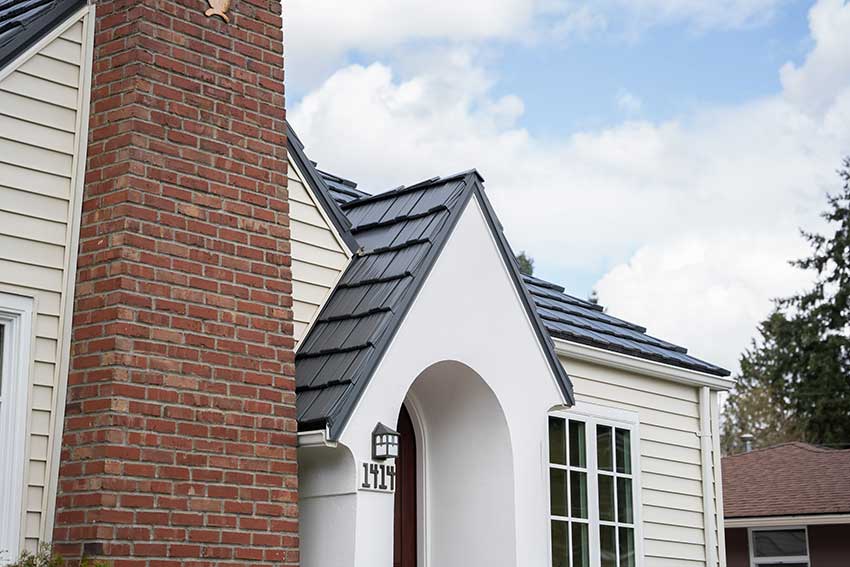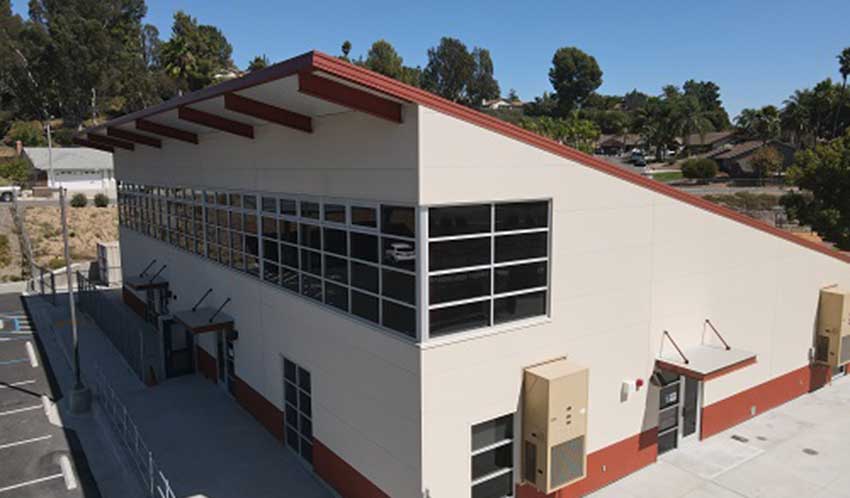Enduring Metal
Unique qualities make metal a smart building solution for sustainable design
Sponsored by Metal Construction Association | By Erika Fredrickson
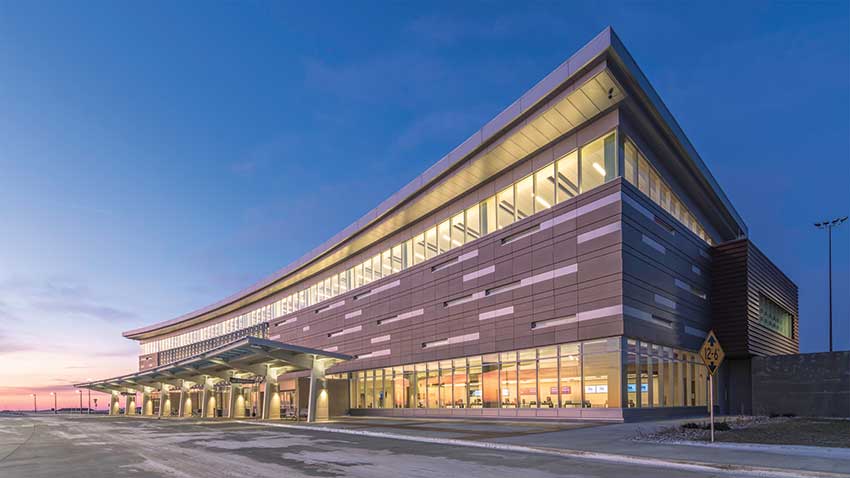
Photo courtesy of Brennan Photo + Video
Williston Basin International Airport was designed to be both people-centered and reflective of Williston Basin’s beautiful limestone and prairie landscape. It features 60,000 square feet of insulated metal panel walls (IMPs) that provide long-term durability, low maintenance, and high thermal capabilities—all of which support the health and comfort of travelers as well as contribute to essential sustainability goals.
A MULTITUDE OF BENEFITS: METAL BUILDING PANELS FOR WALLS AND ROOFS
A Brief History: How Durability Became Sustainability
Durability is defined as the power to withstand wear, pressure, and damage. Within the built environment, durability holds an even deeper meaning: it implies the building’s power to resist the forces of nature all around it over time—and without losing its structural integrity, essential function, and aesthetic goals. The building is a resilient structure, built to last.
It might seem more obvious today that a durable building would also provide environmental and cost benefits because of its inherent attributes. But durability has not always been a priority in the long list of considerations—even among those in the construction industry. According to the U.S. Environmental Protection Agency (EPA) archives, the green building movement sprung up in the 1960s and 1970s as a response to environmental movements and high oil prices, both of which spurred research on energy efficiency and renewable resources. For a few decades, the focus on green building was on minimizing energy and water use and reducing the use of excessive construction materials. Green building was sometimes seen as a niche approach, but as elements of durability have been included in its definition, it has become clear to many in the field that both environmental and durability considerations—together—constitute sustainability.
A building that has been designed to last for 60 years provides more resource advantages over a building built to last for 30 years, especially if indoor environmental quality (IEQ) and energy performance are comparable. The durable products and materials that compose the longer-lasting building will not need frequent replacements or repairs. Plus, the embodied carbon from, and investment in, the raw materials, as well as the energy and environmental impacts, are diffused over a longer period.
The idea is that the long life cycle of durability will usually make up for the environmental and economic deficits. Of course, this is a simplification, but it still provides a helpful way to look at durable products. There are exceptions and caveats that make durable (or resilient) design more complex—and for architects, more interesting. For instance, durable designers might also consider how a building will be assessed and used in the future. Why would they do this? If a building loses its value because it no longer seems useful or aesthetically appealing, it might be renovated or demolished—which means it never met its full life-cycle potential or paid off in terms of economic or environmental benefits.
Keeping this in mind, durable design could also include an element of foresight in which the architect selects materials and a design approach based both on structural resilience and the building’s usefulness. That might mean a design that features flexible spaces that can—rather than being scrapped—be converted to new uses in the future.
Metal on the Rise
Metal is a versatile building material, boasting both historical credentials and modern aesthetics. It has often been seen as durable and practical, a fine material for warehouses, but not always as a particularly “green” or especially beautiful material. Sustainability research and assessments have provided ways of measuring metal’s true role as an environmental asset. In addition, the metal industry has found new ways to manufacture metal for beautiful and modern designs, leading to the wide variety of applications it has today in commercial and residential architecture.
In recent years, metal has risen in popularity as a favored construction material. Beyond it being more accessible than ever, metal has a multitude of compelling qualities and capabilities that have earned it the right to rise to the top.
Those benefits include design aesthetics, energy efficiency, durability, fire protection, ease of installation, rainscreen installation capabilities, and the quality of being low maintenance. These benefits provide the means to achieve the important elements of the built environment: architectural vision and occupant health, safety, and well-being.
Metal Roofs
Many conventional roofing products, including asphalt shingles, contribute about 20 billion pounds of waste per year to U.S. landfills. Metal roofs, however, can often be installed onto existing roofs (depending on local building codes), eliminating the environmental impact—and costs—of disposal. Added to that benefit is the fact that metal roofs already exist as somewhat of an eco-product themselves because they are often made of recycled material.
Metal roofs have a variety of design options to fit nearly any architectural desire. Besides the wide array of colors, metal roofs can be specified in a multitude of shapes and profile configurations. They come as traditional standing seam profiles or can be manufactured to resemble shake, slate, shingles, or clay tiles. Let’s look at a few types of metal roofs and discuss their characteristics.
Low Slope Metal Roofs
Low slope metal roofs have a long history as a preferred covering for commercial, institutional, and industrial buildings. That’s because they are a high-performance, low-maintenance, cost-effective choice with practical capabilities: They protect against the elements and keep building contents and occupants dry.
As building owners and architects explore sustainable designs, low slope metal roofs are also appreciated for their many benefits, including long service life that saves money. Their low life-cycle costs, recyclability, light weight and other environmental qualities also provide significant advantages.
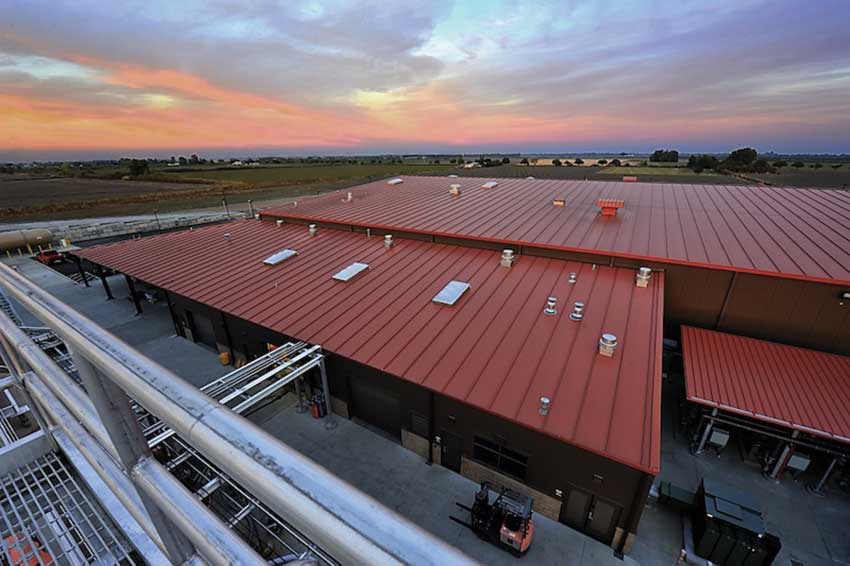
Photo courtesy of Metl-Span
Low slope metal roofs are the historical choice for commercial buildings because of their long service life, which saves money. Their low life-cycle costs, recycled content, recyclability, light weight, and other environmental qualities are appealing across the board.
Low slope structural roofing is usually used on roof pitches ranging from ¼:12 to 3:12. It consists of interlocking panels, called standing seam roofing, that run vertically along the roof surface. These panels generally come with a painted finish or a clear acrylic finish. All metal roofing used on low slope applications requires machine seaming during installation to ensure a watertight seal.
A seaming apparatus is placed onto the standing seam and run on top of the seam, seaming/rolling it to either a 90 or a 180-degree seam.
The standing seam design provides draining from rain and snow, eliminating leaks and ponding. The fact that low slope metal roofs are not prone to degradation like some other roofing materials means they are good in wet climates and achieve a long life span with low operating costs.
Steep Slope Metal Roofs
Steep slope metal roofs are defined as roofs with pitches of 3:12 or greater. They are known for both durability and aesthetics. In instances where a commercial building requires an attractive and affordable steep slope, this is the roof type building owners and architects often select.
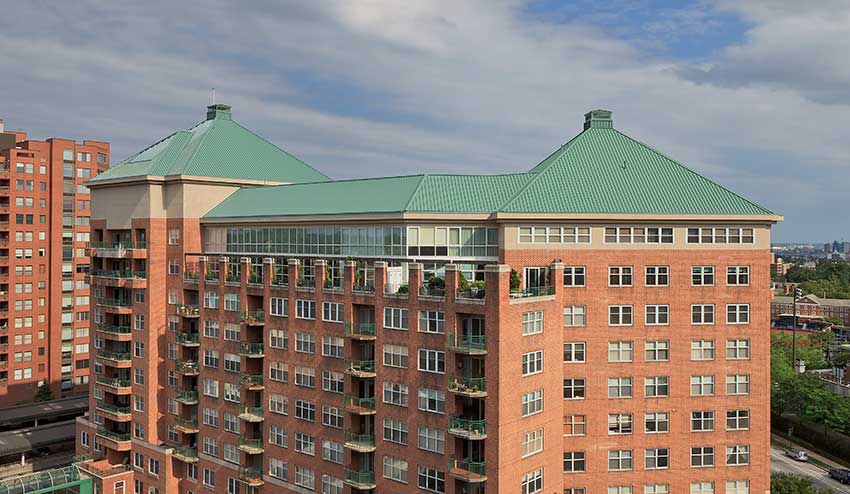
Photo courtesy of ATAS International
Steep slope metal roofs are known for their eye-catching capabilities and often selected by architects for that reason.
They are also favored by environmentally sensitive building owners and architects who appreciate the roof's aesthetic appeal, long service life, low-maintenance requirements, light weight, and wind resistance.
For architects who want eye-catching design, steep slope metal roofs come in a variety of shapes and an array of coating colors. Their steep design accelerates the rate of water run-off, protecting them from debris, mold and mildew, and UV or acid rain degradation. The design preserves its aesthetic but also its life span, which has led metal roof manufacturers to typically warranty their products for 20–40 years.
Insulated Metal Panel Roofs
Insulated metal panel roofs, or IMPs, are an innovative metal roof product composed of interior and exterior steel facings bound to an insulating foam core. IMPs feature strong insulating properties, recycled content, a ridged feel, and a streamlined architectural aesthetic. The product has strong spanning capabilities and can be installed quickly.
IMPs can be installed on both low slope roofs and steep slope roofs for the benefit of commercial or residential projects. The product rates high on weathertightness and fire protection. And in terms of aesthetics, IMPs come in a multitude of colors to meet design goals.
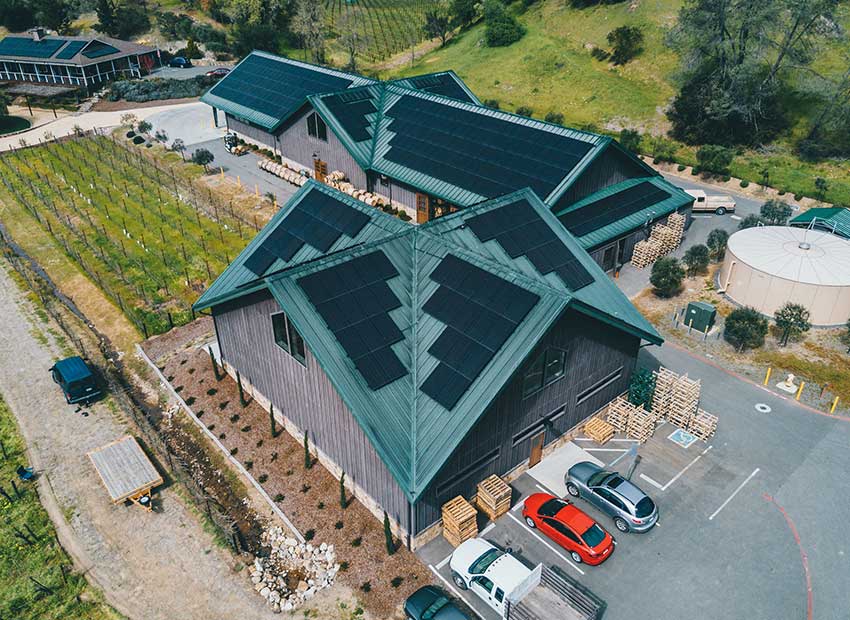
Photo courtesy of All Weather Insulated Metal Panels
The insulated foam in IMP roofs provides weathertightness and temperature control, which is essential to places such as this winery. The standing seam roof creates a perfect platform for the solar panels.
Metal Walls
Like metal roofs, metal walls offer sustainable and aesthetic benefits in commercial and residential construction. Currently, they are seen most often in commercial, institutional, municipal, and industrial buildings, but as their popularity continues to rise, they are popping up in residential homes and condos in new and unique ways.
These days, metals walls come in a variety of colors, textures, and designs. They can be specified in matte or shiny finishes. They can be shaped into a variety of patterns. Metal walls can set a mood, evoke an occupant’s personality, or match a neighborhood’s architectural style by looking either ultra-modern or vintage.
Metal walls are durable. They can restrict the spread of fire and can meet the conditions of and acceptance of NFPA 285. They can also serve as a rainscreen when paired with a weather-resistant barrier, preventing water from entering the building. In climates with lots of rain, having a metal barrier can extend the life of the building by preventing mold and decay. And, by preventing mold and decay, the metal panels provide better indoor air quality for occupants.
Metal’s density means that metal walls can lead to a reduction in energy consumption and that lowers expenses for building owners. Two other ways they save money include their easy and quick install and the fact that they often don’t need as much support structure as other materials.
Because they don’t require as much support structure, due to the inherent lightweight of metal, a building designed with metal walls can use fewer materials, which is also eco-friendly. In general, metal walls meet regulations for sustainable materials. They are made of recycled material and can be turned back into new materials. In a time when countries across the world are looking to hit climate change mitigation targets, buildings with metal walls can do their part to lower the carbon footprint.
Metal wall panels don’t dent or ding easily, which means they can preserve their aesthetic value for many years. This can contribute to fewer renovations, less waste, and a longer life.
Let’s look at types of metal walls and their characteristics.
Insulated Metal Panels
We previously discussed the qualities of insulated metal panels (IMP) made of lightweight metal skins with an insulating core. They come in a variety of colors and are easy to install, and they provide high-level thermal capabilities. IMPs work well in a variety of building types, such as offices, warehouses, educational institutions, government, transportation, and hotels—almost anywhere. They are especially suited for spaces with many occupants where temperature, humidity, airborne particles, and air movement must be dialed in.
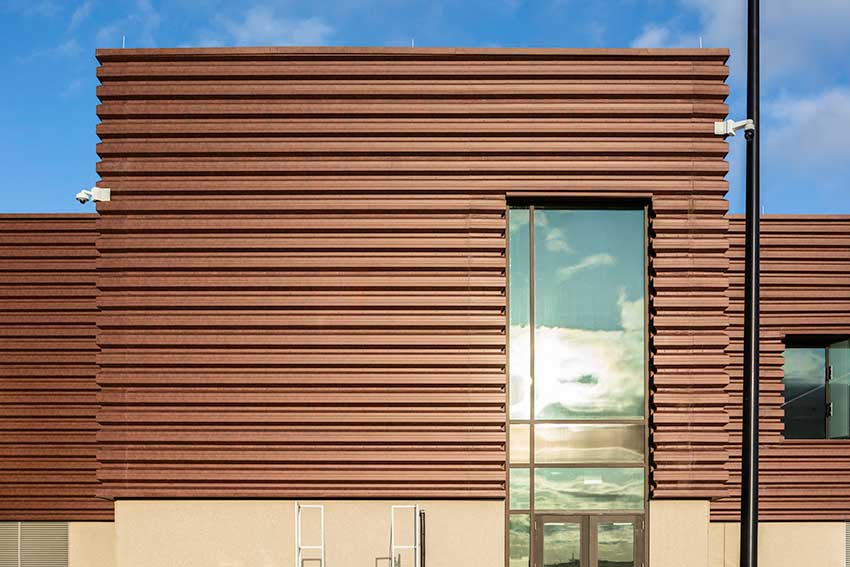
Photo courtesy of Brennan Photo + Video
IMP walls come in a variety of colors to match any aesthetic, such as the earthen, prairie color in this close up of the Williston Basin International Airport.
Their insulating properties serve climate-controlled facilities well. That includes manufacturing, processing, storage, or distribution of perishable foods or other products. They are available in thicknesses between 3” and 6” and can be designed to fit the thermal needs of the building. In addition, the panels can include high-performance coatings and special joint designs and details to meet hygiene and contamination requirements for these types of spaces.
In terms of aesthetics and architectural design, IMPs are extremely customizable. They can be specified for shape and width, colors and finishes, and fabrication for bent corners and curved panels. Options for panels that integrate with windows, louvers, sunshades, and other whole building solutions are available and provide architectural freedom in their flexibility.
Metal Composite Material
Metal composite material (MCM) evolved from an aluminum composite material (ACM) introduced 50 years ago. It now comes in natural metal skins such as zinc, copper, stainless steel, and titanium, though aluminum is still the dominant selection for construction.
MCM has a modern look and is versatile enough that it provides room for imagination. This material is produced as a flat sheet and can be installed to retain the flatness or curved into a variety of architectural shapes. Finishes, colors, and textures allow MCM to turn buildings into works of art, which means architects and building owners can get creative with their designs.

Photo courtesy of Dan Schwalm© 2020 HDR; 3A Composites USA, Inc.
Metal composite material (MCM) is a popular aesthetic choice for architects. It is cost-effective and, being made of 70% recycled material, meets sustainability goals.
MCM is especially popular because of its aesthetics but also because it is affordable. Once limited to high-end projects, MCM’s advances in technology, improved fabrication, and efficient installation techniques have brought the price down to being more competitive. In some instances, it lowers construction costs and keeps building costs low over time due to its durability. Maintenance often entails paint finishes but not much more. It is now a favorite material for a wide range of building types: major commercial, educational, and health facilities, and it is used in corporate identity applications and architectural cornices and soffit designs.
In many ways, MCM meets some of the goals of a holistic view on durability: It retains its curb appeal and can remain updated. Added to the durability factor is the fact that about 70% of an MCM by weight is recycled content.
Single Skin Walls
Preformed, or roll-formed, single skin metal panel systems have been around for decades but are becoming more popular. They are manufactured from metals such as steel, aluminum, copper, and zinc. Recent improvements in the manufacturing process have resulted in a greater variety of profiles to choose from.
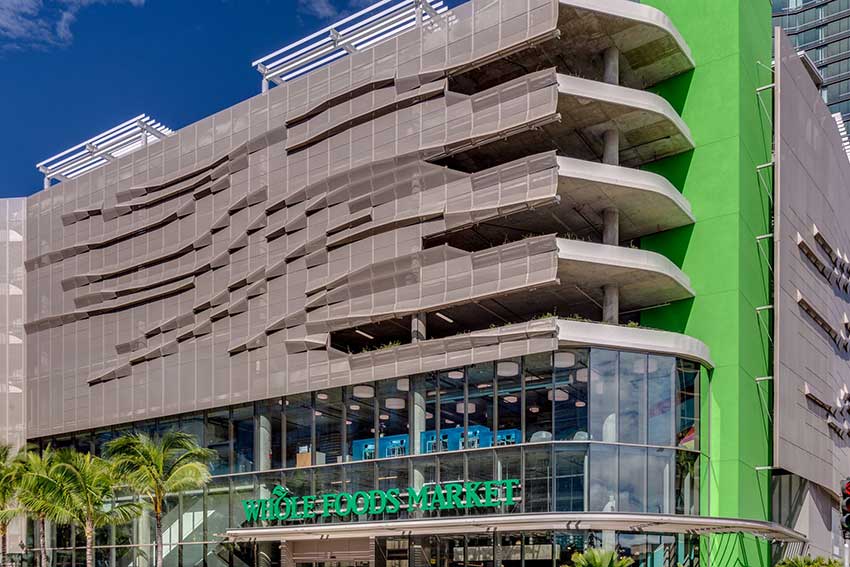
Photo courtesy of Northclad
Single skin metal panel systems are durable and come in a wide variety of profiles that can be selected for innovative designs.
New coating technologies applied during the manufacturing process offer extra durability, while new design options have expanded their reach into the commercial building market.
Single skin metal is also versatile in perforated applications. It provides yet another aesthetic design element for architects, while also providing other benefits. Used for the facades of buildings such as parking garages, the perforated skins provide a method to control solar heat gain by keeping the space cool but still letting in light.
SPECIFYING FOR CRADLE-TO-CRADLE METAL CONSTRUCTION
According to Architecture 2030, a non-profit, nonpartisan, and independent organization working to mitigate climate change through architecture, the built environment generates nearly 50% of annual global C02 emissions. Of those total emissions, building operations are responsible for 27% annually, and building materials and construction are responsible for an additional 20% annually. The global emissions from materials and construction are known as embodied carbon and their production—from extraction to manufacturing and transportation in between—has led to the release of greenhouse gases (GHGs) into the atmosphere.
Architecture 2030 reports that the issue of high emissions from buildings is compounded by the fact that global building is expected to double by 2060. To think about it in more concrete terms: That’s like adding a New York City to the planet every month for 40 years. With such a daunting view before it, Architecture 2030 and other leaders in the industry are looking to change the course by changing the role of construction. The idea is to transform the built environment from major emitter to problem solver.
One of the most critical aspects to construction is the embodied carbon that comes from the manufacturing, transportation, installation, maintenance, and disposal of building materials. Unlike operational carbon emissions, which can be reduced over time with building energy upgrades and the use of renewable energy, embodied carbon emissions are locked in place as soon as a building is built.
Using materials like metal that provide energy efficiency, endless recyclability, and durability can provide long-lasting benefits that support net-zero goals in the built environment. The idea of durable products such as metal walls and roofs as solutions to a larger world problem fits well into the cradle-to-cradle philosophy.
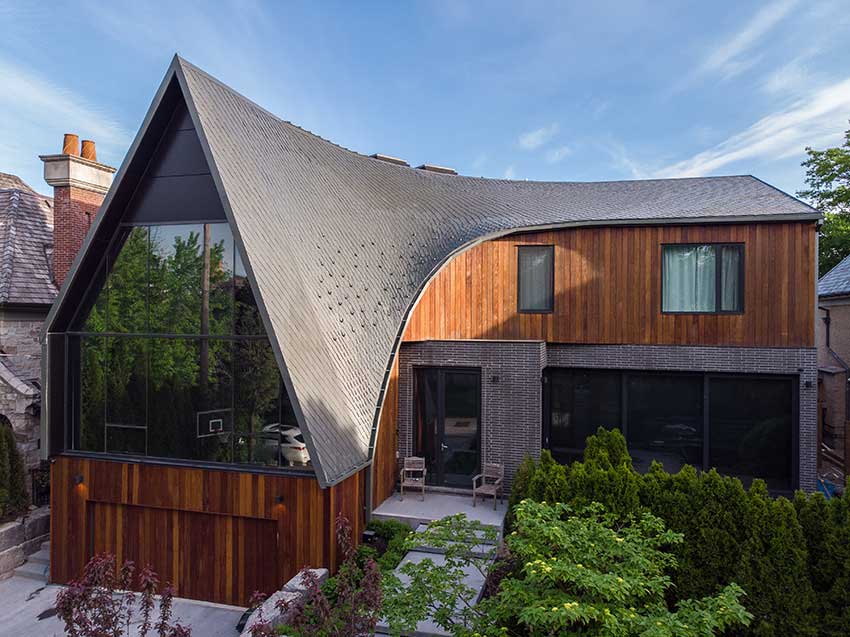
Photo courtesy of Greg van Riel Photography; RHEINZINK
Using metal for roofs and walls can cut back on embodied carbon emissions because metal is endlessly recyclable, energy efficient, and durable enough to contribute to a long life span for the building.
Cradle-to-cradle design is an idea that uses nature’s processes as a model for the built environment, including its products and systems. Whereas the idea of cradle to grave restricts focus on a product or system from birth to death, cradle-to-cradle encourages a more holistic approach in which the architecture, engineering, and construction industry is sustainable and considerate of its impacts from one generation to the next.
Specifying metal roofs and walls for a cradle-to-cradle design would include considering the sustainability characteristics featuring energy efficiency, recyclability, and durability. Considering how to optimize these traits for a building’s location and function promises that a project is serving that cradle-to-cradle approach. Seeking out the right products can assist a project in meeting requirements of Cradle to Cradle (C2C) and the Leadership in Energy and Environmental Design (LEED) green building rating system. In addition, these sustainability goals within the cradle-to-cradle approach often support health, safety, and wellness goals—which makes sense because the idea is about building spaces that model on nature’s ecosystems.
When specifying for metal roofs and walls, there are a few ways to obtain verifiable product performance information. Key to transparency and product performance assurance are independent, third-party labels, evaluations, and program certifications such as UL GREENGUARD Gold and Declare and product reports such as Environmental Product Declarations (EPDs) and Health Product Declarations (HPDs). These third-party evaluations provide assurance, credibility, and verification that manufacturers themselves cannot provide, and they are the path toward certified buildings.
Life-Cycle Assessments
A life-cycle assessment or analysis (LCA) is one way that products are assessed for sustainability. It is a type of environmental accounting commonly used for assessing environmental impacts associated with all stages of a commercial product, process, or service’s life cycle. When applied to multiple assemblies at the building level, it is referred to as a Whole Building Life-Cycle Assessment (WBLCA). Green building rating systems such as LEED and Envision include credits for performing WBLCA and choosing less impactful materials and systems. This is a cradle-to-grave assessment that can be used in the broader goal of a cradle-to-cradle approach.
In a whole building LCA study by Houston-based Walter P. Moore Associates on behalf of the Metal Building Manufacturers Association, the environmental impact of metal buildings was found to be lower in case studies comparing structural and envelope materials to load-bearing concrete, masonry, tilt-up, and steel-framed construction within the same basic building footprint. The study concluded that in buildings where metal is typically most economical, LCA performance is also better, with the least embodied building material impact.
EPDs and HPDs
An Environmental Product Declaration (EPD) report summarizes the life-cycle impact of a product from “cradle to grave” based on a product’s LCA. An EPD report includes information about a product’s global warming potential, its potential toxicity, and manufacturer’s sustainability initiatives, among other things. EPDs do not rank products. Instead, an EPD is a transparency tool that helps specifiers make choices based on the sustainable qualities and environmental impacts. Products with EPDs can contribute to LEED and WELL credits.
A Health Product Declaration (HPD) is similar to an EPD but is focused on the health impacts of the product. HPDs are shared by manufacturers to disclose a product’s ingredients and any health hazards associated with these ingredients. HPDs may be created by product manufacturers, by manufacturer’s agent, or by a third party. As with EPDs, an HPD is a transparency document that allows a specifier or building owner to compare the health impacts of products using a standardized format. Products with HPDs can also contribute to both LEED and WELL credits. Third-party verified contributes more than self-verified products.
With the concept of sustainability now being widely embraced by the architectural community, metal roofs and walls are being seen in a new light. Metal roofing can contribute significantly to the sustainable building movement. Their high recycled content, total recyclability, energy efficiency, and the ability to utilize “cool” finishes allow "cool metal roofs" to qualify for LEED points.
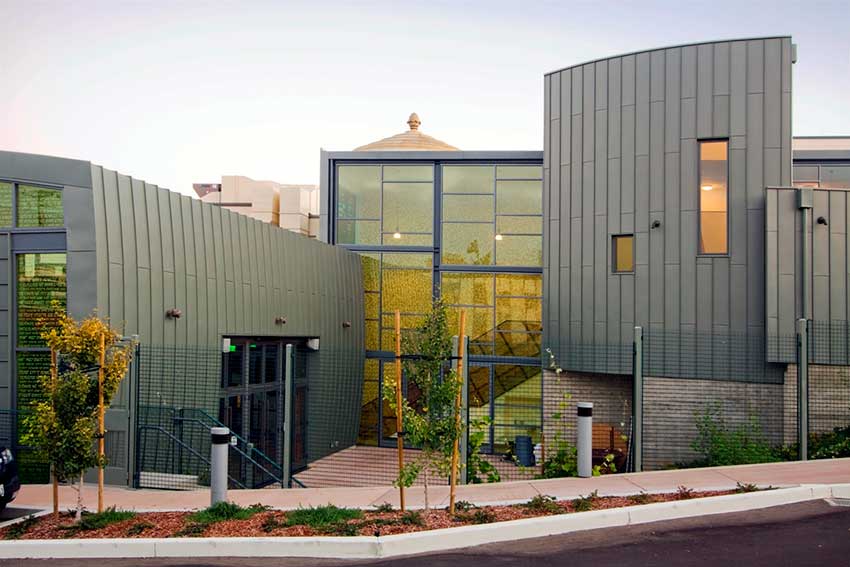
Photo courtesy of Northclad
The content of steel, aluminum, and copper metal roofing and wall material contains substantial amounts of recycled materials, making them excellent candidates for LEED credits.
Recyclability
While the most widely known LEED credit for roofing is for the heat island effect, metal’s high recycled content, total recyclability, and smooth, impervious surface allow metal to meet requirements for other points in the LEED program as well.
Metal is the world’s most recycled material. Iron, including its refined product steel, is the most widely used of all the metals, and the recycling of iron and steel scrap (ferrous scrap) is an important activity worldwide. Because it is economically advantageous to recycle iron and steel by remelting and casting for use in the manufacture of new steel products, a significant industry has developed to collect old scrap, including used and obsolete iron and steel products, and new ferrous scrap generated in steel mills and steel-product manufacturing plants. The North American steel industry’s overall recycling rate is 71%, according to the Steel Recycling Institute.
Consequently, the content of steel, aluminum, and copper metal roofing material is comprised of substantial amounts of recycled materials, making them excellent candidates to be considered for the LEED credits focused on Materials and Resources.
Most steel sheet products are produced through the basic oxygen furnace process, which uses 25%–35% old steel to make new steel. Figures for pre-consumer and post-consumer recycled scrap may vary slightly at individual furnaces making steel around the country. And architects and builders will certainly want to ask their metal panel supplier to provide them with their product’s recycled content.
Aluminum is recycled extensively from both post-consumer and pre-consumer sources. According to the Aluminum Association, the recycled content of domestically produced, flat-rolled products for the building and construction market is approximately 80%–85%. Aluminum Alloy 3105, the aluminum product used in nearly every aluminum standing seam roofing application, is produced from 99% scrap, 80% of which is from post-consumer sources. The aluminum coil used comes from state-of-the-art, scrap-based aluminum mini-mills producing a variety of common alloy sheets. The association notes that, in addition, at the end of its long, useful life, aluminum roofing can be repeatedly recycled back into similar products with no loss of quality.
Copper is a routinely recycled metal with the highest scrap value of any building metal. Copper’s high cost makes it a favored product for collection and sale to nonferrous scrap-recycling companies. The average recycled content of all copper products is 44.6%. Copper roofing and wall cladding contains 75% scrap. Almost 50% of this is post-consumer scrap.
How do metal roofing and wall cladding manufacturers gain LEED compliancy? It must be made clear that the U.S. Green Building Council does not certify products, but only buildings, in the LEED program. However, a product’s sustainable attributes can help earn credits and points toward a building’s LEED certification.
Documentation and Other Challenges
Trying to track down material resources including the substrate manufacturer's information on recycled content or location of manufacture can be challenging. Some metal panel manufacturers who have been working with LEED projects and architects are aware of this need and have the information, including letters and other forms of verification from substrate manufacturers. It is important that for projects pursuing LEED certification, that specifications and bid packages provide clear directions about points of origin of the metal and manufacturer distance requirements (for example, 100 miles or less from the project site), and for recycled content requirements.
Metal panels may play an indirect role in qualifying for other LEED credits as well. Ultimately, metal panels present architects and builders with an opportunity to use the products’ sustainable attributes in a LEED project. When amassed with other rating points for various sustainable features, metal can be a simple and cost-effective way to meet program requirements.
THERMAL AND ENERGY-SAVING BENEFITS OF METAL
Metal provides many thermal and energy-saving benefits. This section looks at all the ways metal provides energy-saving benefits to a project by way of reflective pigment technology that results in overall energy efficiency and lowers utility bills. There are a variety of coatings that can keep metal cool in the summer and warm in the winter. These energy saving benefits are not just environmental solutions; they provide health, safety, and well-being to occupants in the space. Thermal qualities ensure the comfort of occupants.
Cool roofs can reduce heat transfer to the indoor environment, thereby lowering air conditioning costs. Studies monitoring buildings in California and Florida demonstrate that cool roofs save residents and building owners 20–70% in annual cooling energy use, and cool metal roofing can qualify for tax incentives and earn LEED credits.
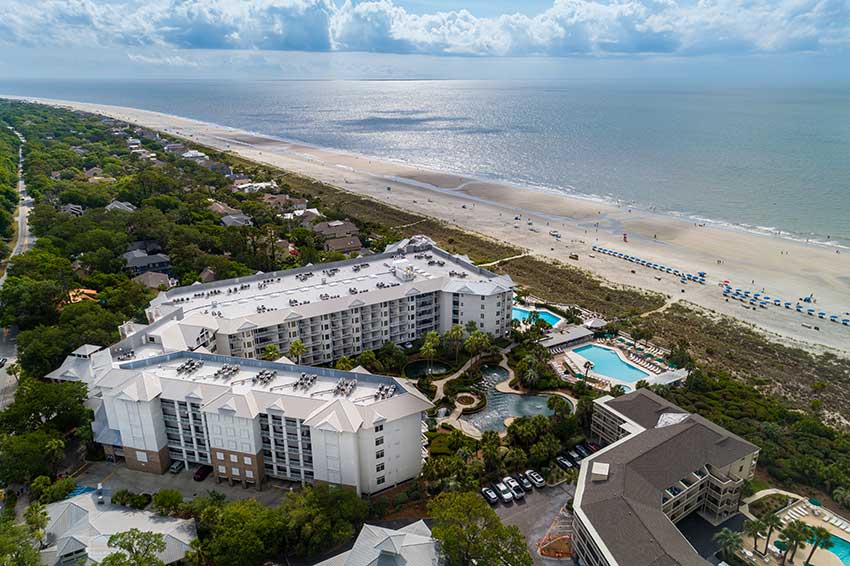
Photo courtesy of Tedlar
Cool roofs, like this one at an oceanfront Hilton, can reduce the heat island effect, lower air conditioning costs, and minimize negative impact on microclimate and human and wildlife habitat.
Cool roofs can also reduce thermal gradient differences between developed and undeveloped areas to minimize impact on microclimate and human and wildlife habitat.
The temperatures in the air above heat islands can be as much as 12 degrees Fahrenheit hotter than the surrounding suburbs, leading to higher air conditioning costs, greater use of electricity, and higher levels of smog and ozone.
The U.S. Department of Energy research has shown that one additional percent of reflectivity in a roof coating on average will reduce the roof temperature by one degree. The ultimate result is that heat is reflected away from buildings, smog is reduced, energy costs are lowered, and the life expectancy of the roof will be increased due to less expansion and contraction.
Cool roofs reflect heat well across the entire solar spectrum, especially in the infrared and visible wavelengths. In addition to absorbing less heat, the coolest roofing materials radiate away any absorbed heat.
Regardless of the kind of material used, cool roofs have two important surface properties: a high solar reflectance and a high thermal emittance. Solar reflectance, also called albedo, is a measure of the ability of a surface material to reflect sunlight—including the visible, infrared, and ultraviolet wavelengths—on a scale of 0 to 1, which can be expressed as a decimal fraction (0.7) or a percentage (70%). Essentially, it is the percentage of solar energy that is reflected by a surface.
Thermal emittance is defined as the percentage of energy a material can radiate away after it is absorbed. It is the ability to release absorbed heat. Scientists use a number between 0 and 1 (or a percentage) to express emittance.
Solar reflectance and thermal emittance have noticeable effects on temperature. Some conventional roof surfaces have low reflectance (from 5%–25%) and high thermal emittance (typically over 80%). These surfaces can heat up to 150–190 degrees Fahrenheit at midday during the summer. Bare metal or metallic surfaced roofs often have a high solar reflectance (typically 50% or higher) and may have low thermal emittance (anywhere between 2% and 66%), depending on their surface treatment. These surfaces warm to 140–170 degrees Fahrenheit. Cool roofs with both high reflectance and high emittance warm to only 100–120 degrees Fahrenheit in the summer sun.
Under LEED v4, in the heat island reduction credit in the sustainable sites category, roofing materials used on low slope roofs with a slope of less than 2:12 must now meet a minimum initial solar reflectance index (SRI) of 82 (or a 3-year aged SRI of 64), while steep-sloped roofs with a slope of more than 2:12 must have a minimum SRI of 39 (or a 3-year aged SRI of 32).
According to these requirements, an SRI is defined as "a measure of the constructed surface's ability to reflect solar heat as shown by a small temperature rise. It is defined so that a standard black (reflectance of 0.05 and emittance of 0.90) is zero (0) while the SRI for a standard white (reflectance of 0.80 and emittance 0.90) is 100."
To calculate the SRI for a given material, it is necessary to obtain the reflectance and emittance values for the material. SRI is calculated according to ASTM E 1980. This is a standard practice for calculating the SRI of horizontal and low-sloped opaque surfaces with emissivity greater than 0.1. Reflectance is calculated according to any one of three ASTM standards—ASTM E 903, ASTM E 1918, or ASTM C 1549. Emittance is calculated according to ASTM E 408 or ASTM C 1371.
Cool Colors
Tests have shown that on a 90 degrees Fahrenheit day, a white roof will only have a temperature of 110 degrees Fahrenheit at its surface while a black roof will have a reading of 190 degrees Fahrenheit. However, it would be a very dull country if architects and builders could not enhance the appearance of their products and were restricted to white, despite the energy savings. Consequently, roof coating manufacturers have been developing cool roof coatings that increase heat reflectivity and reduce emissivity without sacrificing color choices.
New infrared-reflective pigments incorporated into paints used on architectural metal roofing products allow them to achieve higher reflectivity values, even in darker colors such as black and brown. This improved reflectivity—the reflectivity for black, for example, changes from 0.07 with normal pigments to 0.32 with infrared-reflective pigments—can mean a much cooler surface temperature and greater energy savings for the building below. This allows facility executives to select a sustainable roof without having to sacrifice aesthetics.
Research shows that most of the cool roof coatings and colors available today have little or no trouble meeting the reflectivity standards for LEED. Some, however, would fall short in meeting emissivity requirements if the entire roof surface required it.
Energy Performance
Most industry experts agree that reflectivity has a greater impact than emissivity on the energy performance of the roof during hot weather. If most of the initial solar radiation is reflected, then a smaller portion is left for infrared emittance. Many cool roofs have reflectivities of 75%–80%, which means that only 20%–25% of the sun's energy is absorbed into the roof.
According to the Lawrence Berkeley National Laboratory, at an ambient temperature of 98 degrees Fahrenheit, a change in a roof’s emissivity from 0.75 to 0.90 while keeping reflectivity constant results in a surface temperature reduction of 2 degrees. Conversely, raising a roof’s reflectivity from 0.25 to 0.40 while keeping emissivity constant results in a surface temperature reduction of 13 degrees, a substantial difference.
Still, the combination of high reflectivity and high emissivity during hot summer months results in a surface temperature sometimes as much as 60–70 degrees cooler than a nonreflective roof. The reduction in heat energy means less need for air conditioning and lower energy costs.
In the case of LEED, a qualified laboratory can determine the solar reflectance required by the program. The laboratory does not need to be independent of the material manufacturer; therefore, both third party and manufacturer laboratories can be used to provide data to the Environmental Protection Agency (EPA).
However, the Cool Roof Rating Council (CRRC), an independent, non-profit industry association, requires that the laboratory conducting the measurement be accredited. Either the lab must be listed as an Accredited Independent Testing Laboratory (AITL) by the CRRC or it must be an Accredited Manufacturers Testing Laboratory (AMTL) to perform the tests to determine reflectivity and emissivity. Both the AITL and the AMTL must meet the requirements of the CRRC, which includes ISO certification of the lab, as well as additional required CRRC training.
Solar-Ready Roofing
Metal is the ideal choice for both crystalline and building integrated photovoltaic (BIPV) solar systems because of its long service life. When installing a crystalline system (typically warranted for 25 years of power generation), a building owner benefits from a roofing substrate that has a greater life expectancy than the solar panels. Standing seam metal panels also provide a natural platform for attaching crystalline systems without any roof penetrations. Additionally, highly reflective roofs with cooler rooftop temperatures result in better performance of solar panels.
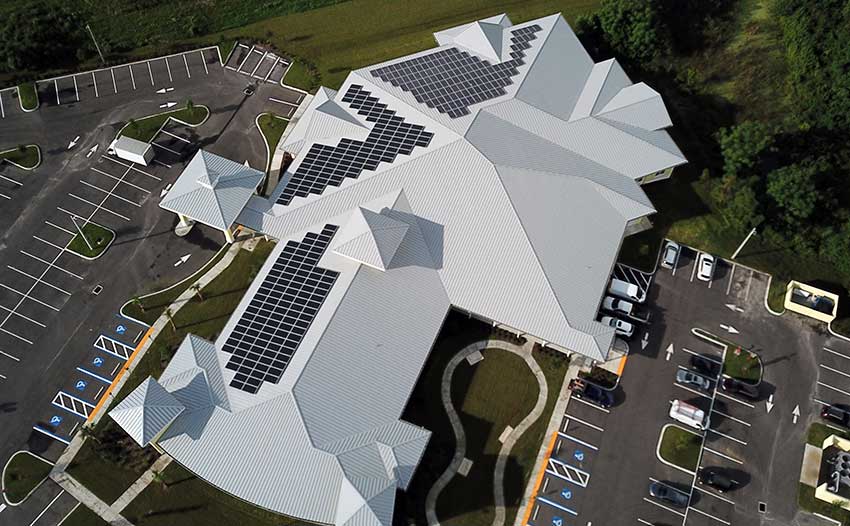
Photo courtesy of ATAS International
Because metal roofs have such a long life expectancy, they are ideal for solar panels.
Living Building Challenge
The Living Building Challenge (LBC) was launched in 2006 and is considered the world’s most rigorous green building standard. There are close to 400 projects around the world pursuing the certification but only 20 or so that are fully certified.
To become a certified Living Building, projects must meet 20 imperatives within seven performance areas, known as Petals: Place, Energy, Water, Materials, Health and Happiness, Equity, and Beauty. The imperatives are performance-based and position the ideal outcome as an indicator of success.
One of the biggest challenges within the LBC is meeting the material requirement, which focuses on transparency and how a product impacts the environment and human health. For all metal products, including roofs and walls, the biggest challenge is figuring out how they fit within the Materials Petal, which is intended to create a materials economy that is nontoxic, ecologically restorative, transparent, and socially equitable. Other Materials Petal imperatives include embodied carbon footprint, responsible industry, living economy sourcing, and net positive waste.
For a lot of products, LBC is a challenge in big part due to the red list of 22 classes of banned and toxic substances found in many building materials. As manufacturers work through those logistics, architects should be able to specify for metal to meet these requirements.
The result of the LBC is a zero-energy building that combines energy efficiency and renewable energy generation to consume only as much energy as can be produced onsite through renewable resources over a specified time period. This ambitious challenge is not out of reach for metal roof and wall systems—a current LBC building utilizes lots of metal, as we will see in the case studies. Metal’s inherent thermal properties and efficiencies help move buildings toward that goal, and the metal manufacturing world is always evolving toward the cradle-to-cradle aspiration.
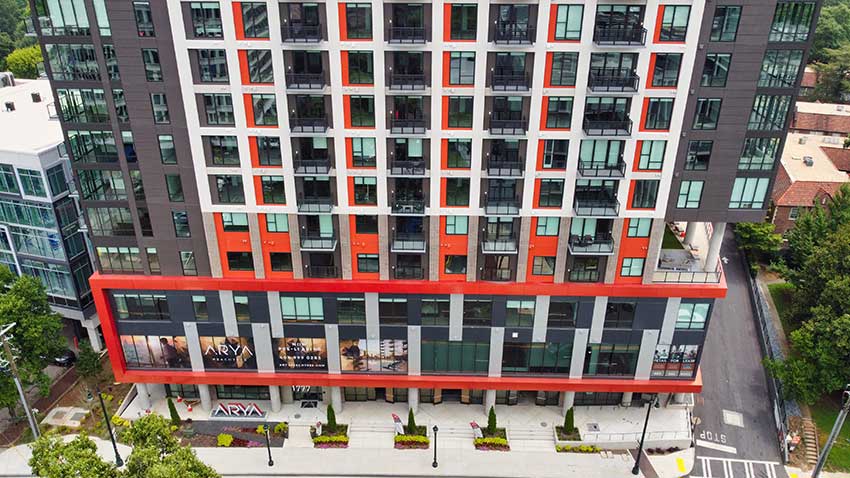
Photo courtesy of Isaiah Industries
Metal products like MCM are sustainable and offer health and well-being advantages due to their low toxicity and fire resistance, and, over the years, the design options have expanded to provide a modern look that is versatile enough for architectural visions across the spectrum.
HOW METAL CONSTRUCTION BENEFITS THE JOBSITE
Metal construction has another appealing aspect: it can help support the sustainability of jobsites. Pre-engineered metal roofing and wall systems offer a way to reduce the amount of material left on site. The building can even be constructed without the hazards, extra time and clean-up of coating, since the metal is painted at a coil coating facility. Factory painted metal also means that construction crews are not exposed to any paint chemicals.
CONCLUSION AND REVIEW
These days, designs that center on sustainability and IEQ are highly prioritized by architects, developers, and owners alike. As we have learned in this course, metal can meet many of these goals. As an endlessly recyclable, highly durable material, metal fulfills requirements for LEED projects and serves as part of the built environment’s solution toward mitigating climate change. Just as important is the occupant, to whom metal provides low-toxic and fire-resistant qualities. Its properties can control temperature, moisture, and sound—all while offering aesthetically pleasing elements that create a sense of comfort and well-being.
Erika Fredrickson, is a writer/editor focusing on technology, environment, and history. She frequently contributes to continuing education courses and publications through Confluence Communications.
The Metal Construction Association brings together a diverse industry for the purpose of expanding the use of metal in construction through marketing, research, technology, and education. MCA member companies gain tremendous benefit from association activities that focus on research, codes and standards, market development, and technical programs. www.metalconstruction.org
Originally published in Architectural Record
Originally published in August 2022
LEARNING OBJECTIVES
- Discuss how the durability of metal panels leads to sustainable building projects.
- List some key qualities of metal panels that support LEED certification, including acoustical health and well-being.
- Explain the thermal capabilities and applications of metal construction that support health and comfort of the occupant.
- Describe the ways in which metal’s resistance to fire and rain help keep occupants safe, comfortable, and healthy.

